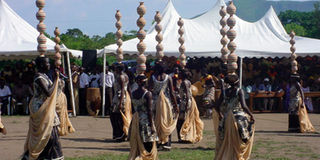Uganda’s pottery culture

Ndere Troupe dancers balance pots on their heads as they perform a traditional dance at a function in Kasese recently. Among the Batooro and Banyoro, pots play a big cultural role. Photo by Felix Basiime.
What you need to know:
Our Heritage: From east to west, north to south, pots in Ugandan culture have rich connotations ranging from strengthening relationships among family members to a sign of respect to elders. We explore this functional and cultural symbol in Tooro
There are things that are often ignored in our communities, which have a bearing on human life. Their connotations are of great importance, yet remain unknown to many Ugandans.
Uganda is a country with a rich cultural heritage as recognised by The United Nations Educational, Scientific and Cultural Organisation (Unesco). This cultural diversity often represents the way of life of people in a given community. Whether you meet them in an office or on the road, the cultural instinct often beams through one’s speech, smile, dress code or greetings.
This adequately connects to the social setting in which one is groomed. Activities such as marriage, naming rituals, wedding, and burials have specific cultural utensils, short of which such a function is rendered incomplete. But aren’t these cultural utensils irrelevant in this era of modernity? Can’t they be replaced with modern ones? Hardly! They are indispensable tools for such functions, whose importance goes beyond their physical appearances.
Among the cultural tools deeply entrenched in people’s ways of life are pots. Although they might sound old fashioned, pots still carry a heavy meaning across all regions in Uganda. You will be surprised to find out that pots even determine how you relate with friends.
In the original Bunyoro-Kitara kingdom, Banyabindi was a group of people specialising in pottery. In Runyakitara, the name Banyabindi was coined from the economic activity they were known for. Pots are called Ebibindi, and therefore Banyabindi literally means “people who make pots”. The Banyabindi would move around the Bunyoro-Kitara empire in search of clay for pottery, a skill that is said to have originated from their ancestors.
In those days, their main role was to supply pots to Bunyoro-Kitara kingdom (before it split into Bunyoro, Tooro, Rwenzuru and the newly recognised Budhingiya bwa Bwamba kingdoms).
Besides being used in palace rituals, pots are part of the domestic utensils for various purposes. Thus, most of the tribes in western Uganda regard them as essential tools in their families.
For instance, pots serve as traditional “fridges” for keeping drinking water cold. “Water from the pot has a unique taste,” says Stephen Rwagweri, the executive director of Engabu Za Tooro Cultural Organisation.
They also work as traditional plates, mainly for traditional cultural functions. “For instance, even today, during cultural functions, people gather and have a meal from one pot,” Rwagweri explains. This signifies mutual obligation to guarantee life to one another, a sign of a shared life.
Among the Batooro and Banyoro, pots are used during the Empako - naming rituals. “On such functions, they put smoked beef in the pot around which people gather and share the meal. This is a sign of shared life,” Rwagweri explains, as he reminisces the unique taste of pot-cooked beef. Additionally, they are used to invoke the family gods and to prepare a meal to appease them, though this practice is diminishing.
Rwagweri stresses that the significance of pots has a bigger impact on human life. “Pots are indispensable tools in Tooro culture. They are used on introduction rituals to signify shared life, togetherness and to grantee life to one another,” he adds.
With the emergence of modern plates and saucepans, many thought the pots would be wished away. Not at all. Pots are still relevant. “For marriage functions, you cannot use modern plates, you use pots. Pots are also used during burials.
After burial, they use pots to wish somebody long life. It is a sign of consolidation. However, here, it is strictly done only when the dead is a family head (a man),” he says. The offspring of the dead gather around one pot and eat smoked beef, an act that signifies reconsolidation, to keep children or family members together.
Pots are also used to train carefulness because if you don’t handle it with care, it can fall down and break. “It is something to do with being serious and careful.
Skills of steadiness in handling precious things were among the most emphasised,” Rwagweri stresses. For instance, a new woman in marriage would be tested with a pot. They would send her to fetch water at the well to see if she could carry the pot without breaking it. Should she break it, she would be perceived as a reckless woman.
The Banyankole make milk-pots, meat dishes, water pots and troughs for fermenting beer.
The pot in other cultures
Buganda.
Tofiri Malokwezi, an elder, says in the past, during marriage functions, the family of the bride to be would fetch water from the pot in the house and give it to the groom to be as a sign of friendship, an act that signifies the relationship between two families.
The Acholi.
Moses Tulu, 51, from Gulu, says, pots among the Acholi are mainly used for carrying water and cooking food. They are a symbol of cultural identity during marriage. The two-mouthed pot, however, is used in some rituals, like the birth and initiation of twins.
The Bagwere.
Kakaire Tuutu, the minister of culture in Bugweri chiefdom, says in thier culture, pots are regarded as house utensils. Not much ritual significances




